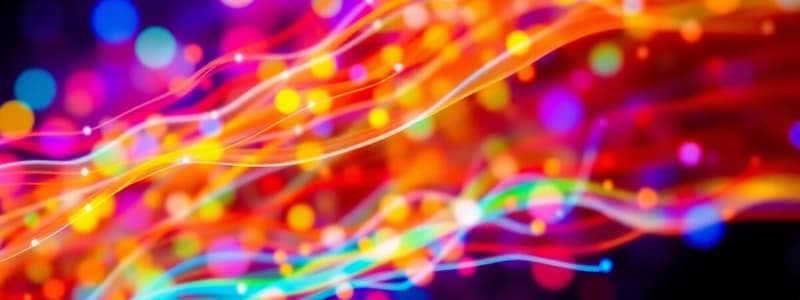Podcast
Questions and Answers
What is the primary characteristic of fluorochromes regarding light?
What is the primary characteristic of fluorochromes regarding light?
- They only emit light when stimulated by high temperatures.
- They do not change the energy of the light they emit.
- They absorb light and re-emit it at a lower energy and longer wavelength. (correct)
- They absorb light and re-emit it at a higher energy.
Which fluorochrome has an absorption maximum between 450 and 550 nm?
Which fluorochrome has an absorption maximum between 450 and 550 nm?
- Phycoerythrin (PE)
- Fluorescein Isothiocyanate (FITC) (correct)
- Peridinin Chlorophyll Protein (PerCP)
- Allophycocyanin (APC)
What type of analysis can be performed using fluorescein isothiocyanate (FITC) in clinical laboratories?
What type of analysis can be performed using fluorescein isothiocyanate (FITC) in clinical laboratories?
- CD4 absolute counts (correct)
- Environmental sample analysis
- Kinetics studies of cell function
- Multi-drug resistance studies
Which parameters can be classified as intrinsic parameters in measurements?
Which parameters can be classified as intrinsic parameters in measurements?
What role does Phycoerythrin (PE) play in fluorescence applications?
What role does Phycoerythrin (PE) play in fluorescence applications?
In which application is flow cross-matching used?
In which application is flow cross-matching used?
Which of the following statements is true about fluorescent dyes and antibodies?
Which of the following statements is true about fluorescent dyes and antibodies?
Which of the following fluorochromes is a protein?
Which of the following fluorochromes is a protein?
What does forward scatter (FSC) in flow cytometry primarily indicate?
What does forward scatter (FSC) in flow cytometry primarily indicate?
What is detected at a 90-degree angle to the laser beam in flow cytometry?
What is detected at a 90-degree angle to the laser beam in flow cytometry?
Which property of a cell does side scatter (SSC) reveal?
Which property of a cell does side scatter (SSC) reveal?
What occurs to a fluorescent molecule when illuminated by a laser in flow cytometry?
What occurs to a fluorescent molecule when illuminated by a laser in flow cytometry?
What is essential for recognition and enumeration in flow cytometry?
What is essential for recognition and enumeration in flow cytometry?
In flow cytometry, what does the fluorescence intensity indicate?
In flow cytometry, what does the fluorescence intensity indicate?
What is the purpose of using band pass filters in flow cytometry?
What is the purpose of using band pass filters in flow cytometry?
How is scattered light converted for analysis in flow cytometry?
How is scattered light converted for analysis in flow cytometry?
Flashcards are hidden until you start studying
Study Notes
Flow Cytometry Basics
- Flow cytometry utilizes lasers to analyze the physical and chemical characteristics of cells or particles in a fluid stream.
- Forward Scatter (FSC) measures the size of cells or particles based on light scattered in the forward direction.
- Side Scatter (SSC) assesses internal complexity and granularity of particles, providing insight into their structure.
Forward Angle Light Scatter (FSC)
- Light scattered in the forward direction is proportional to the square of the cell's radius, indicating cell size.
- FSC provides critical data on cell size, aiding in identification and classification.
Side Scatter Channel (SSC)
- SSC detects light scattered at 90 degrees to the laser beam, reflecting the internal complexity of the cells.
- Higher SSC values indicate greater granularity and internal organization within cells.
Fluorescence Channels
- Fluorescent molecules on cells absorb laser energy and emit it at longer wavelengths, enabling detection of specific compounds.
- The intensity of emitted fluorescence correlates with the amount of fluorescent compound present.
Optical Design Components
- System includes photomultiplier tubes (PMTs) for capturing scattered light and fluorescence signals.
- Dichroic filters and band-pass filters are used to isolate specific wavelengths of light for analysis.
Electronic Data Processing
- Scattered light from cells is converted to digital values for computerized analysis.
- The conversion allows for quantitative assessment of cell characteristics and fluorescence intensity.
Fluorochromes and Antibodies
- Monoclonal antibodies can be conjugated with fluorochromes for specific cell identification.
- Different fluorochromes (e.g., FITC, PE) have unique excitation and emission spectra, allowing multiplexing in assays.
- FITC absorbs light between 450-550 nm, commonly used in immunofluorescence.
Clinical Laboratory Applications
- Flow cytometry is vital for immunophenotyping, including HIV and leukemia diagnostics.
- It enables accurate CD4 absolute counts, reticulocyte enumeration, and residual white blood cell detection.
Research Laboratory Applications
- Used in studying immune function, hematopoietic stem cells, and multi-drug resistance in cancer.
- Assists in various kinetic studies, environmental sample analysis, and flow together with FISH techniques.
Measurement Types
- Intrinsic parameters include cell size and granularity, while extrinsic parameters encompass surface antigens.
- Surface antigens are detected using fluorochrome-conjugated monoclonal antibodies (e.g., CD45, CD4).
Fluorochrome Characteristics
- Examples include FITC, PE, PerCP, and APC, each exhibiting specific fluorescent properties upon light excitation.
- Some fluorochromes are proteins while others are small organic compounds, like FITC.
Principles of Fluorescence
- Governed by the equation E = hf, relating energy (E), Planck's constant (h), and frequency (f) of the emitted light.
- The relationship between frequency and wavelength is defined by ν = fλ, where ν represents speed of light.
Spectral Characteristics
- Excitation and emission spectra for fluorochromes define their effective uses in flow cytometry, determining optimal light conditions for detection.
Studying That Suits You
Use AI to generate personalized quizzes and flashcards to suit your learning preferences.




